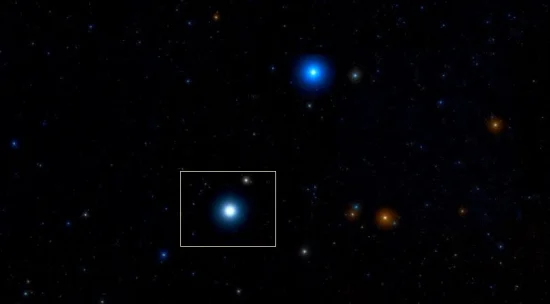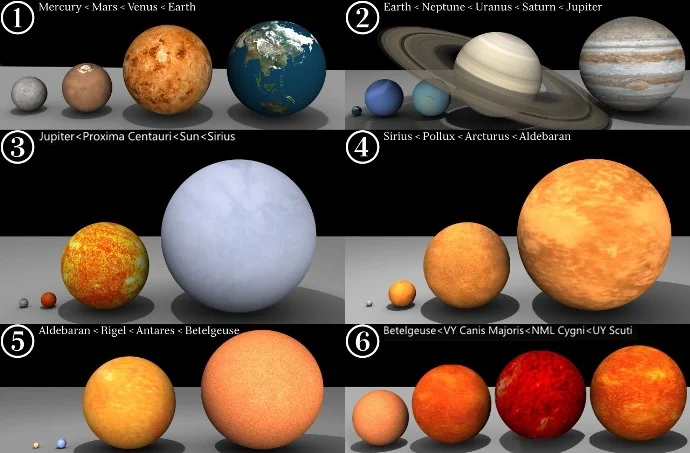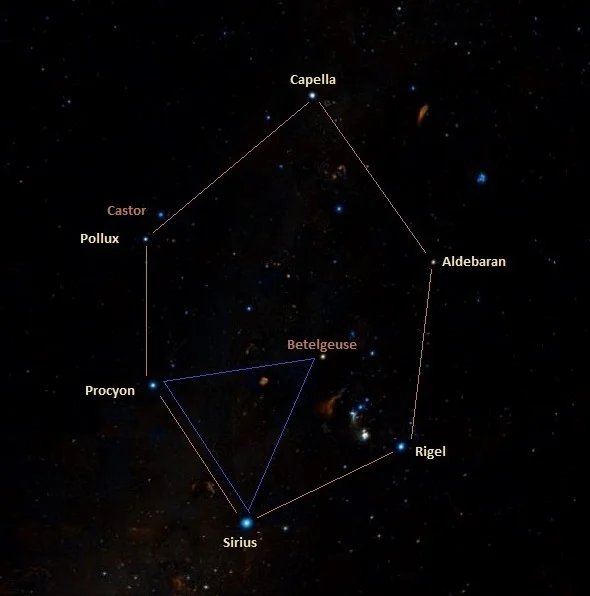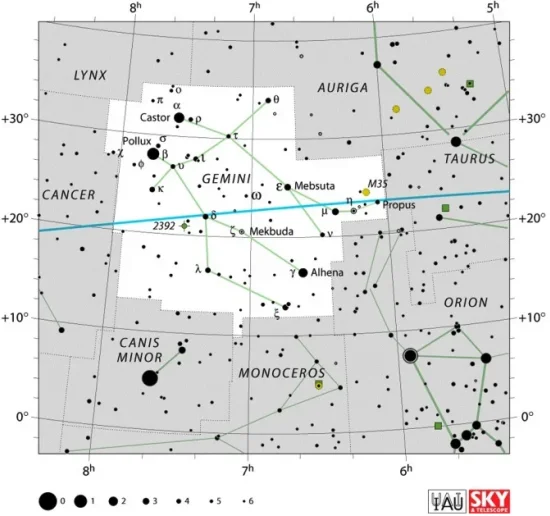Pollux, Beta Geminorum (β Gem), is an orange giant star located in the constellation Gemini. With an apparent magnitude of 1.14, it is the brightest star in Gemini and the 17th brightest star in the sky. It is only slightly fainter than Antares in the constellation Scorpius and Spica in Virgo, and it just outshines Fomalhaut in Piscis Austrinus and Deneb in Cygnus. Pollux lies at a distance of 33.78 light years from Earth. It is the nearest giant star to the solar system.
Pollux and its neighbour Castor mark the heads of the celestial Twins, represented by the constellation Gemini. The two stars are about 18 light years apart. Even though they are referred to as twins and appear similar in brightness, the two stars are very different. Pollux, which is slightly closer to us, is a single star, while Castor is a star system consisting of six stars.
Star type
Pollux is an evolved giant, orange in colour, with the stellar classification K0IIIb. The “b” indicates that the star is less luminous than average for its class.
Pollux is an intermediate mass star, almost twice as massive as the Sun and almost nine times larger. With an estimated temperature of 4,666 K, it shines with a luminosity 43 times that of the Sun. The star’s estimated age is 724 million years.

Pollux (Beta Geminorum), image: Wikisky
Pollux is believed to have started its life as a main sequence star of the spectral type A, but eventually spent its supply of hydrogen and evolved into an orange giant. It will keep getting bigger until it reaches the end of its life cycle. As it is not massive enough to go out as a supernova, Pollux will end its life by expelling its outer layers to form a planetary nebula, leaving behind a compact white dwarf.
Observations carried out from 2007 to 2009 revealed that Pollux has a weak magnetic field at the surface, one of the weakest magnetic fields ever detected on a star. The field indicates that Pollux used to be an Ap star, a chemically peculiar class A star with overabundances of certain metals, which had a considerably stronger magnetic field than it has now.
Planet
An extrasolar planet orbiting Pollux, named Pollux b (or Beta Geminorum b), was confirmed in 2006. Scientists suspected its presence since 1993, when a team at University of Texas at Austin measured precise relative radial velocities for three class K giant stars: Pollux, Arcturus and Aldebaran. They found long-period variations in the relative radial velocity of all three stars (a period of 558 days for Pollux), too long to be a result of radial pulsations. The team concluded that these variations might be due either to non-radial pulsations, to a surface feature combined with rotation, or to the presence of a substellar companion with a mass 3 to 12 times that of Jupiter.
The existence of Pollux b was announced on June 16, 2016. American astronomer Artie P. Hatzes, who had originally published his hypothesis in 1993 and also discovered planets orbiting the stars Epsilon Eridani and HD 13189, is credited for the discovery.
Pollux b has a mass of at least 2.3 Jupiter masses. It orbits the star with a period of 589.64 ± 0.81 days (1.61 years) at a distance of 1.64 astronomical units. (For comparison, Mars orbits the Sun at an average distance of 1.5 AU). With an eccentricity of 0.02, the planet’s orbit is almost circular.
Pollux b was given the proper name Thestias, after Leda, the mother of Castor and Polydeuces in Greek mythology. Leda was the daughter of the Aetolian King Thestius and was sometimes called Thestias. The name was approved by the International Astronomical Union (IAU) in December 2015 after a public nomination and vote. The name that was originally submitted for the planet by the Australian research project theSkyNet was Leda, but the IAU requested that it be substituted for the patronym Thestias because the name Leda had already been given to one of Jupiter’s satellites, as well as to an asteroid.
Facts
Pollux has served as a spectral standard for its class, K0III, since 1943. The other spectral standard for this class is Aljanah, Epsilon Cygni A, a single-lined spectroscopic binary star system located near the Veil Nebula in the constellation Cygnus.
Pollux is the only star in Gemini listed among the 58 selected stars for navigation.
A study published in 2000 revealed that Pollux showed small amplitude variations in radial velocity, but that it was not photometrically variable.
Pollux is located at about the same distance from Earth as Arcturus (36.7 light years), the brightest star in Boötes and in the northern celestial hemisphere (and the fourth brightest of all stars). This provides astronomers with an opportunity to compare two similar stars, both exceptionally bright, located at the same distance. Both stars are orange giants (K0III), but Arcturus appears considerably brighter (mag. -0.05) because it is intrinsically more luminous than Pollux, with an absolute magnitude of -0.30. It is about 170 times more luminous than the Sun, while Pollux shines with 43 solar luminosities. Arcturus is also much older, with an estimated age of 7.1 billion years.

UY Scuti compared to other stars, image: Wikimedia Commons/IStoleThePies (CC BY-SA 4.0)
Pollux currently lies 6.7 degrees north of the ecliptic, but will come close enough to it in the future to be occulted by the Moon and planets.
Name
The name Pollux comes from Greek and Roman mythology. Pollux (or Polydeuces) was the son of Zeus and Leda and the twin half-brother of Castor, who was born to a mortal father.
The International Astronomical Union’s (IAU) Working Group on Star Names (WGSN) officially approved the name for Beta Geminorum on December 15, 2015.
The 17th century Egyptian astronomer Al Achsasi al Mouakket listed the star as Muekher al Dzira in his Calendarium. The name was later translated into Latin as Posterior Brachii, meaning “the end in the paw.” In Arabic astronomy, Castor and Pollux constituted one of the front paws of an enormous lion, which stretched across a third of the sky. The stars of Canis Minor represented the other paw, Regulus was the forehead, Arcturus and Spica the shin bones, and the stars of Corvus, the hind quarters.
The Chinese name for the star is 北河三 (Běi Hé sān), or the Third Star of North River, referring to the asterism North River, formed by Pollux with Castor and Rho Geminorum.
Castor and Pollux
In Greek and Roman mythology, Castor and Pollux were twin brothers born to different fathers, one immortal (Zeus) and the other mortal (Tyndareus). They were the sons of the Spartan Queen Leda, wife of Tyndareus, and brothers of Helen of Troy and Clytemnestra, wife of Agamemnon, king of Mycenae. Pollux was the son of Zeus, who had seduced Leda in the form of a swan, and Castor was the mortal son of the Spartan king.
When Castor met his end in a family feud, Pollux asked his father, the god Zeus, to keep the two of them together, and Zeus gave him the choice to either live on Mount Olympus or give his brother half his immortality. Pollux chose the latter and Zeus granted the brothers an alternate immortality, allowing them to spend half their time on Olympus and the other half in Hades. He also turned the brothers into the constellation Gemini. The twins were considered patrons of sailors and travellers, to whom they granted favourable winds and help in distress.
In Greek and Roman cultures, the twins are also known as the Dioscuri, Castores, Tyndaridae, Tyndarids and Gemini. They were later also associated with Hercules (Pollux) and Apollo (Castor).
In early Arabic astronomy, Pollux was called Al Thani al Dhira, meaning “the Second in the Forearm,” but later came to be known as Al Ras al Taum al Mu’ah.h.ar, or “the Head of the Hindmost Twin” and as Al Ras al Jauza’, or “the Head of the Twin.”
The Babylonians knew the star as Mu-sir-kes-da, meaning “the Yoke of the Inclosure” and saw it as part of the asterism called Mash-mashu-arku, or “the Eastern One of the Twins.” Assyrians called Pollux and Castor Mas-mas, meaning “twins.”
In India, the stars were known as Acvini, the “horsemen.”
Location
Pollux is very easy to find because it is one of the brightest stars in the night sky and because it is one of the stars that form the Winter Hexagon, a large asterism that dominates the evening sky during the northern hemisphere winter. The other stars of the Winter Hexagon are Procyon in Canis Minor, Sirius in Canis Major, Rigel in Orion, Aldebaran in Taurus and Capella in Auriga. All six are first magnitude stars.

The Winter Triangle and the Winter Hexagon, image: Wikisky
Pollux and Castor can be located by drawing an imaginary line from Rigel through Betelgeuse, which leads in the direction of two stars that appear similar and are relatively close to each other. Castor, the slightly fainter of the two, is closer to Capella, the brightest star in Auriga’s pentagon pattern, while Pollux is closer to Procyon and Sirius. Castor also appears whiter than the yellowish Pollux.
Constellation
Pollux is located in the zodiac constellation Gemini. Prominent in the winter sky in northern latitudes, Gemini is a popular target for stargazers because it contains several interesting deep sky objects. The open cluster Messier 35 is a large, rich magnitude 5.3 cluster with more than 120 stars brighter than magnitude 13. It lies 3.5 degrees to the northwest of the red giant Tejat (Mu Geminorum), at the opposite end of Gemini to Castor and Pollux, near the border with Taurus.

Gemini constellation map by IAU and Sky&Telescope magazine
Located near Lambda Geminorum, next to the border with Canis Minor, the Medusa Nebula is a large old planetary nebula once believed to be a supernova remnant. It is best seen in 8-inch or larger telescopes.
The Eskimo Nebula (NGC 2392) is a somewhat brighter planetary nebula known for its peculiar shape, which has also earned it the nickname the Clown Face Nebula. Visible in small telescopes, the nebula lies near Wasat (Delta Geminorum), between Kappa and Lambda Geminorum.
The Jellyfish Nebula (IC 443) is a supernova remnant that can be seen at Castor’s foot, between Tejat and Propus (Mu and Eta Geminorum) and not far from the Monkey Head Nebula (NGC 2174) in the constellation Orion.
The best time of year to observe the stars and deep sky objects in Gemini is during the month of February, when the constellation is prominent in the evening sky.
The 10 brightest stars in Gemini are Pollux (Beta Gem, mag. 1.14), Castor A (Alpha Gem A, mag. 1.93), Alhena (Gamma Gem, mag. 1.9), Tejat (Mu Gem, mag. 2.86), Castor B (Alpha Gem B, mag. 2.97), Mebsuta (Epsilon Gem, mag. 3.06), Propus (Eta Gem A, mag. 3.15 – 3.90), Alzirr (Xi Gem, mag. 3.35), Wasat (Delta Gem, mag 3.53), and Kappa Geminorum (mag. 3.568).
Pollux – Beta Geminorum
| Spectral class | K0IIIb |
| Variable type | suspected |
| U-B colour index | +0.86 |
| B-V colour index | +1.00 |
| Apparent magnitude | 1.14 |
| Absolute magnitude | +1.08 ± 0.02 |
| Distance | 33.78 ± 0.09 light years (10.36 ± 0.03 parsecs) |
| Parallax | 96.54 ± 0.27 mas |
| Radial velocity | +3.23 km/s |
| Proper motion | RA: 626.55 mas/yr |
| Dec.: 45.80 mas/yr | |
| Mass | 1.91 ± 0.09 M☉ |
| Luminosity | 43 L☉ |
| Radius | 8.8 ± 0.1 R☉ |
| Temperature | 4,666 ± 95 |
| Metallicity | –0.07 to +0.19 dex |
| Age | 724 million years |
| Rotational velocity | 2.8 km/s |
| Surface gravity | 2.685 ± 0.09 cgs |
| Constellation | Gemini |
| Right ascension | 07h 45m 18.94987s |
| Declination | +28° 01′ 34.3160” |
| Designations | Pollux, Beta Geminorum, β Gem, 78 Geminorum, HD 62509, HR 2990, HIP 37826, GC 10438, LHS 1945, SAO 79666, GCTP 1826.00, LFT 548, LTT 12065, BD+28°1463, PPM 97924, CCDM J07454+2802A, FK5 295, GCRV 5166, GJ 286, IRAS 07422+2808, TYC 1920-2194-1, WDS J07453+2802A |